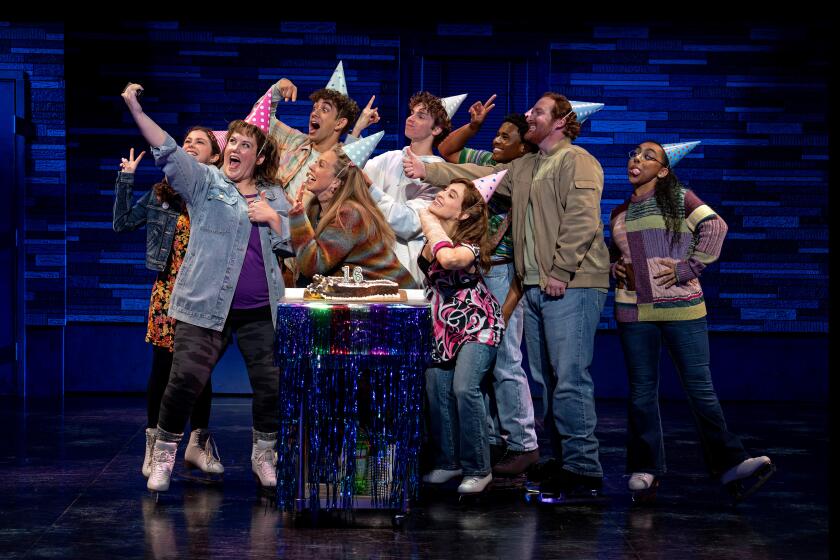CLASSICAL MUSIC / KENNETH HERMAN : Conductor Looks for Life After Sousa, Finds It in Italy
In 1985, when pops conductor Keith Brion last visited San Diego, he did his John Philip Sousa impersonation for the San Diego Symphony’s summer pops. Brion, a former orchestra piccolo player and Yale University bandmaster, has built his peripatetic conducting career around his historically accurate portrayal of the style and programming of “America’s March King.”
“This whole Sousa thing began with a concert I conducted at Yale at 1978. I moved into this thing sideways,” Brion said. “It was a huge success in New Haven, so I took the band to Carnegie Hall, where we got good reviews.”
Before Brion knew it, he had signed with an agent and quickly moved from band conducting to the more lucrative symphony pops circuit. After two years, he left Yale to pursue his new calling as the reincarnate Sousa. His work was aired on public television in 1986, a program called “The New Sousa Band at Wolf Trap,” and he made two recordings of Sousa’s music.
But even Brion began to ask himself if there was life after Sousa, so he put together a news pops program, “Viva Italia!”
“I wanted to include the whole spectrum of Italian music,” Brion said from his hotel in Salt Lake City, where he was doing Sousa again. “I wanted to include Italian opera, folk music--particularly the Neapolitan folk tunes--as well as modern Italian popular songs, including the glitzy ‘Three Coins in a Fountain’ side.”
Brion is also enthusiastic about the orchestral arrangements of Annunzio Mantovani.
“I went to the recorded versions of Mantovani’s traditional Italian music, which, unlike much of his popular ‘elevator music,’ is done with particular sensitivity. His orchestrations for these Italian pieces always include accordion and guitar. The sound of the accordion is very evocative.”
Brion will bring “Viva Italia” to the SummerPops this week, Wednesday through Saturday. He will be joined by tenor Noel Velasco and soprano Charleen Ayers for the operatic arias and duets.
“My whole goal was to find opera pieces that the opera lover will enjoy and the non-opera lover will find accessible. People like the big, heroic, Pavarotti voice. Velasco has the big voice, although not the Pavarotti girth.”
Velasco, who recently sang his Covent Garden debut, and Ayers are both students of American soprano Phyllis Curtin, who taught voice at Yale when Brion was also on the music faculty. Brion has conducted his all-Italian program for the Rochester Philharmonic in 1987 and for the San Jose Symphony last season. Not one to be accused of musical snobbery, he also does a pops program that is a tribute to the late Boston Pops maestro Arthur Fiedler.
“Sousa was a much more artful programmer than Fiedler,” Brion said, “and Fiedler admitted it. I think Sousa would be in favor of San Diego’s programming--its mixture of light classic and novelties, things that are entertaining.
They call it jukebox ballet. While the spirit of glasnost may have moderated the attitudes of American diplomats, members of San Diego’s musicians union, Local 325, American Federation of Musicians, were not shy in expressing their distress over the visiting Bolshoi Ballet’s Civic Theatre performances. Some half a dozen union members picketed several performances last week, complaining that the visiting Soviet ballet troupe was not using live music but taped instrumental accompaniment for its performances here.
Joe Pallazola, president of Local 325, made it clear in a phone interview that his union’s action was an informational picket and not a labor dispute.
“We are not picketing against the Russians,” he said. “We are not picketing against the people presenting this performance. We are picketing against the fact that people are more and more using canned music. People are paying the same price for tickets that they do for ballets backed with live music. This is a trend that has got to be stopped. People have got to realize they are not getting the same quality of (dance) performance without live music.”
Gustavo watch update. Fans of Chula Vista’s most celebrated pianist, Gustavo Romero, will be delighted to learn than he will both conduct and perform at the International Orchestra’s season-opening concert Nov. 17. While Romero left the San Diego area a decade ago to pursue his studies and build his career in New York City, he has returned regularly to perform both solo recitals and concert gigs. In fact, he appears here more frequently than any San Diego-based pianist.
On the November program at Sherwood Auditorium in La Jolla, Romero will conduct the International Orchestra in Mozart’s Symphony No. 29 in A Major, and will solo in Mozart’s Piano Concerto No. 27 in B Flat Major, with music director Zoltan Rozsnyai on the podium. In Mozart’s Concerto for Two Pianos in E-flat Major, Rozsnyai will join Romero in the solo duties at the second keyboard, allowing Romero to play and conduct the concerto.
This concert will open the International Orchestra six-concert series in La Jolla. As in previous seasons, the orchestra will play a second series of four different concerts in San Diego’s College Avenue Baptist Church.
Zorro in the park. Theater organ hotshot Dennis James turned Balboa Park’s Spreckels Organ into an outdoor movie palace last week. To a cheering audience of 2,300, James played a stirring accompaniment to Douglas Fairbanks’ 1920 silent movie classic, “The Mark of Zorro.” No amount of swashbuckling idiocy on screen daunted James’ clever, virtuoso playing. For the past two seasons, James and his crew have packed Symphony Hall in the San Diego Symphony’s “Nickelodeon” silent film series. If you haven’t heard James ply his trade, you’ve missed one of the minor wonders of the moderne age.
More to Read
The biggest entertainment stories
Get our big stories about Hollywood, film, television, music, arts, culture and more right in your inbox as soon as they publish.
You may occasionally receive promotional content from the Los Angeles Times.










